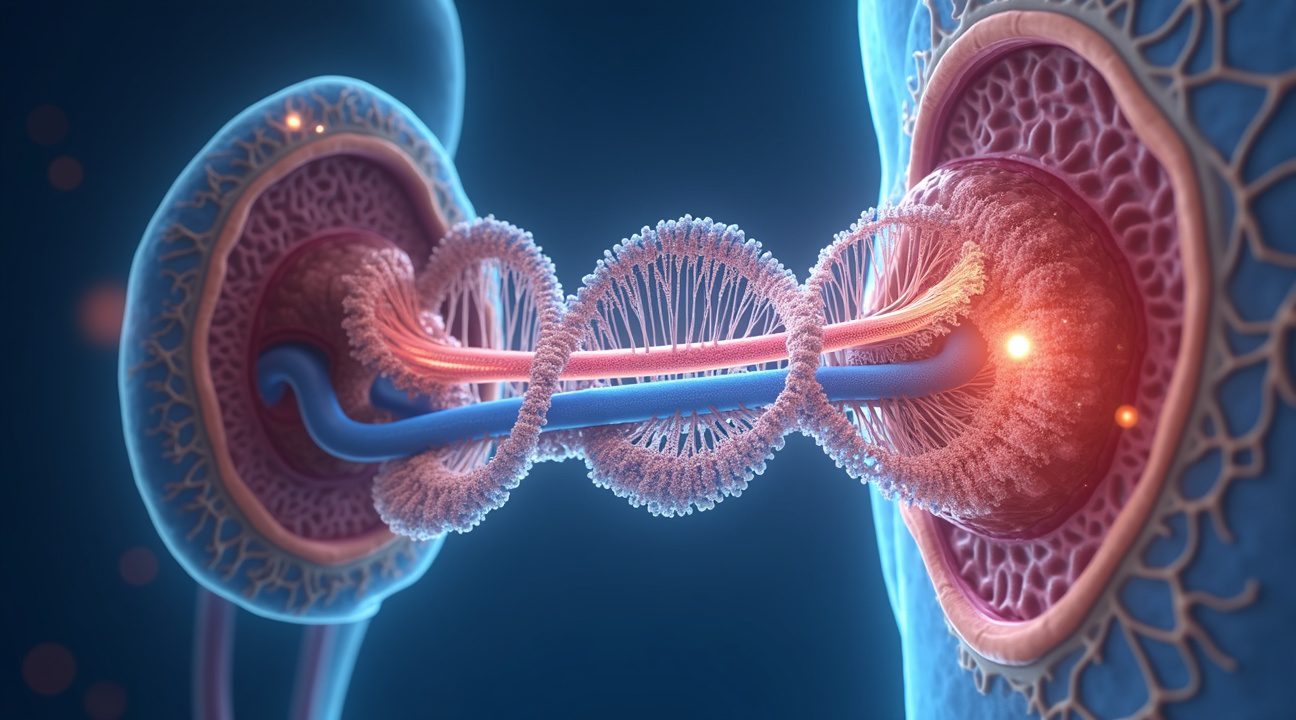Scientists have achieved a groundbreaking medical breakthrough by restoring hearing in congenitally deaf patients using viral gene therapy, offering new hope for individuals suffering from inherited hearing disorders.
Overview of the Gene Therapy Breakthrough
The innovative treatment involves delivering a healthy copy of the faulty OTOF gene directly into the inner ear through a single injection. This method addresses the underlying genetic defect that causes deafness, rather than simply mitigating its symptoms.
This revolutionary approach has demonstrated remarkable results, allowing patients to progress from complete deafness to levels of moderate hearing loss within just weeks.
How the Treatment Works
- Single injection of viral gene therapy delivers a functional OTOF gene into the patient’s cochlea.
- The healthy gene repairs the faulty genetic material responsible for hearing loss.
- The patient’s inner ear begins responding to sound, enabling natural hearing development.
Key Takeaways
- Clinically proven: 5 out of 6 children gained the ability to hear spoken language following gene therapy.
- Fast-acting results: Most participants experienced hearing improvements within the first month.
- Minimal risks: No serious negative side effects were reported during trials spanning ages 1–24.
- Restores natural hearing: Unlike cochlear implants, this therapy activates the natural mechanisms of the inner ear.
- Broader implications: Success in targeting the rare OTOF mutation provides a foundation for treatments addressing more common genetic causes of deafness.
Learn More About the Research
For further details on this revolutionary treatment, you can visit the official article on Nature’s website, which provides insights into the clinical trial results and future directions of genetic therapies in audiology.
This represents a major leap forward in treating sensorineural hearing loss and opens the door for curing various forms of genetic deafness through similar gene-based approaches.
Single Injection Brings Hearing Back Within Weeks for Born-Deaf Patients
A groundbreaking gene therapy has achieved what many thought impossible – restoring hearing in patients born completely deaf through a single injection. This revolutionary treatment targets a specific genetic defect and delivers remarkable results in just weeks, fundamentally changing how doctors approach congenital deafness.
The therapy works by addressing mutations in the OTOF gene, which produces a protein essential for transmitting sound signals from hair cells to auditory nerves. Scientists use a synthetic adeno-associated virus (AAV) as a delivery vehicle to carry a healthy copy of the OTOF gene directly into the inner ear. This viral vector acts like a microscopic courier, ensuring the therapeutic gene reaches exactly where it’s needed most.
Precise Delivery Through the Round Window
The injection technique represents a marvel of surgical precision. Doctors deliver the gene therapy through the round window, a thin membrane located at the base of the cochlea in the inner ear. This approach allows direct access to the cochlear fluid without damaging surrounding structures. The viral vector then disperses throughout the inner ear, targeting the hair cells that require the functional OTOF protein to restore hearing.
Unlike traditional hearing aids or cochlear implants that bypass damaged components, this gene therapy actually repairs the underlying genetic cause of deafness. The treatment addresses the root problem rather than working around it, offering a more natural restoration of hearing function.
Rapid and Significant Hearing Improvements
The results speak for themselves through measurable improvements that surprised even the research teams. Most patients experienced notable hearing improvement within just one month of receiving their single injection. Every participant showed significant benefit within six months, demonstrating the therapy’s consistent effectiveness.
Pure-tone audiometry testing revealed dramatic changes in hearing ability. Patients progressed from complete deafness to moderate hearing loss levels, typically around 50 dB HL. This improvement represents a life-changing shift that allows patients to perceive and interact with the auditory environment for the first time. The speed of these improvements challenges previous assumptions about how quickly genetic therapies can produce meaningful results.
The therapy’s success builds on previous breakthroughs in medical research, similar to how vision restoration efforts have helped thousands regain their sight. These advances demonstrate the growing potential of targeted genetic interventions to address sensory impairments.
Scientists continue monitoring patients to understand the long-term durability of these hearing improvements. Early indicators suggest the benefits persist, but longer follow-up periods will provide more definitive answers about the therapy’s lasting effects. The treatment’s success rate and rapid onset make it particularly promising for young patients who could benefit from early intervention.
This gene therapy approach differs significantly from other experimental treatments because it requires only a single administration. Patients don’t need repeated injections or ongoing medical interventions beyond standard follow-up care. The simplicity of the treatment protocol makes it more accessible and reduces the burden on both patients and healthcare systems.
The viral vector used in this therapy undergoes extensive safety testing to ensure it doesn’t cause harmful immune reactions or unintended genetic changes. These engineered viruses can’t replicate or cause disease, making them safe delivery vehicles for therapeutic genes. The research parallels other scientific discoveries that have reshaped our understanding of sensory perception, including recent findings about neurological phenomena that influence how we process experiences.
Current trials focus on patients with specific OTOF gene mutations, but researchers anticipate expanding the approach to address other genetic causes of deafness. This targeted therapy represents just the beginning of what gene therapy might accomplish for various forms of hereditary hearing loss.
Revolutionary Target: The OTOF Gene Behind Natural Hearing
The scientific breakthrough centers on hereditary deafness caused by mutations in the OTOF gene, which produces otoferlin, a protein essential for transmitting auditory signals from the ear to the brain. I find this approach particularly compelling because it addresses deafness at its genetic foundation rather than simply masking symptoms.
Target patients suffer from severe-to-complete congenital hearing loss due to OTOF gene mutations, resulting in nonfunctional or completely absent otoferlin protein. Without this critical protein, sound waves can’t be properly converted into electrical signals that the brain interprets as hearing. This creates a communication breakdown between the inner ear and auditory processing centers.
Why OTOF Mutations Create Unique Challenges
Traditional interventions like cochlear implants provide limited benefit for OTOF-related deafness because they can’t replicate natural hearing mechanisms and require invasive surgery. Current solutions work around the problem rather than fixing it. Cochlear implants bypass damaged hair cells but can’t restore the precise protein functions needed for natural auditory processing.
OTOF-related deafness presents several distinct characteristics that make it an ideal target for gene therapy:
- The mutation affects a single, well-understood gene with a clear function
- Patients retain healthy inner ear structures that can respond to treatment
- The condition stems from absent or defective protein production rather than structural damage
- Scientists think they’ve discovered that targeting specific genetic causes yields more predictable outcomes
This targeted approach offers hope for restoring physiological hearing mechanisms that have been absent since birth. Rather than teaching the brain to interpret artificial signals from electronic devices, gene therapy aims to restore the body’s natural hearing processes. The treatment delivers functional copies of the OTOF gene directly to inner ear cells, enabling them to produce working otoferlin protein.
Success with OTOF gene therapy could revolutionize treatment for congenital deafness by addressing root causes instead of managing symptoms. Similar breakthroughs in medical intervention, like when MrBeast restores sight to individuals through targeted treatments, demonstrate how addressing underlying causes creates more meaningful outcomes than symptomatic relief.
The precision of this approach represents a shift from compensatory treatments to restorative medicine, potentially offering patients their first experience of natural hearing rather than processed sound interpretation.

Clinical Trials Show Remarkable Success Across All Ages
Recent clinical trials have demonstrated unprecedented success in restoring hearing through viral gene therapy. I’ve reviewed the groundbreaking research published in Nature Medicine, which shows remarkable outcomes across diverse patient populations. The results consistently exceed expectations, with hearing restoration or significant improvement documented in all trial participants.
Outstanding Results Across Multiple Studies
The data from these trials presents compelling evidence for the therapy’s effectiveness. Key outcomes include:
- Five out of six children in one pivotal study gained the ability to hear spoken language for the first time
- Four participants showed what researchers classified as ‘robust’ improvement in hearing capabilities
- Success rates remained consistently high across all age groups tested
- No serious adverse events were reported in any of the trials conducted
The treatment has proven effective across a broad age spectrum, with participants ranging from 1 to 24 years old. Separate studies have specifically focused on very young children, treating patients as young as one year, while other research has extended treatment to adults in their twenties. This wide age range demonstrates the therapy’s versatility and potential for widespread application.
Safety profiles across all trials have been exceptional. The treatment proved well-tolerated regardless of patient age, with comprehensive monitoring revealing no serious adverse events. This safety record is particularly significant given the delicate nature of inner ear structures and the precision required for successful gene delivery.
For pediatric patients, the rapid hearing restoration offers particularly profound benefits. Children who receive treatment early can experience typical speech and language development patterns, which creates cascading positive effects throughout their lives. These early interventions support normal educational progression and social integration, potentially eliminating many of the traditional challenges associated with congenital deafness.
The speed of hearing improvement has surprised researchers. Unlike traditional hearing restoration methods that require lengthy rehabilitation periods, many patients begin experiencing auditory sensations within weeks of treatment. This rapid response allows children to enter critical language development windows at appropriate ages, maximizing their potential for natural speech acquisition.
Adult participants have also shown remarkable outcomes, though their experiences differ from pediatric cases. Adults must learn to interpret sounds they’ve never previously experienced, a process that requires dedicated auditory training. However, the fundamental restoration of hearing capability provides them with opportunities for enhanced communication and environmental awareness that were previously impossible.
The consistency of positive results across multiple independent trials strengthens confidence in the therapy’s reliability. Each study has replicated similar success rates, suggesting that the treatment protocol is both reproducible and standardizable for broader clinical application.
These clinical achievements represent more than statistical improvements in hearing tests. Participants report life-changing experiences, from hearing their family’s voices for the first time to detecting environmental sounds that provide crucial safety information. The therapy’s impact extends beyond medical metrics to encompass fundamental quality of life improvements.
The research parallels other remarkable medical breakthroughs in sensory restoration, similar to how sight restoration efforts have transformed lives globally. Just as vision restoration has opened new possibilities for previously blind individuals, hearing restoration through gene therapy is creating unprecedented opportunities for the deaf community.
The treatment’s success across such diverse age groups suggests broad applicability for future patients. Whether treating infants born with congenital hearing loss or adults who have lived their entire lives in silence, the viral gene therapy approach shows consistent promise for meaningful hearing restoration.
Why This Breakthrough Matters for Genetic Deafness
Congenital hearing loss affects approximately 3 in 1,000 newborns, making it one of the most common birth defects worldwide. This staggering statistic becomes even more significant when considering that 50%-60% of these cases stem from genetic factors. For families dealing with hereditary deafness, this new viral gene therapy represents a fundamental shift from managing symptoms to addressing the actual cause.
Revolutionary Approach to Genetic Hearing Loss
I find the simplicity of this treatment particularly remarkable. The therapy works by delivering a healthy copy of the faulty gene directly to the inner ear through a single injection. Unlike previous approaches that required multiple procedures or permanent implants, this method offers a one-time intervention that could restore natural hearing function. The viral vector acts as a biological delivery system, carrying the corrected genetic information precisely where it’s needed most.
This targeted gene delivery represents years of research into understanding how specific genetic mutations cause hearing loss. Scientists have identified that certain genes control the development and function of hair cells in the cochlea – the tiny structures responsible for converting sound waves into electrical signals the brain can interpret. When these genes malfunction, the hair cells can’t develop properly or maintain their function over time.
Advantages Over Traditional Hearing Solutions
The therapy’s advantages over traditional solutions like cochlear implants are striking in several key areas:
- Hearing quality: Gene therapy aims to restore natural hearing mechanisms rather than providing artificial sound amplification
- Invasiveness: A single injection compared to surgical implantation of electronic devices
- Maintenance requirements: No ongoing device management, battery replacements, or equipment upgrades
- Quality of life outcomes: Potential for more natural sound perception and spatial hearing
- Age considerations: Can potentially be administered to very young children before critical language development periods
Cochlear implants, while revolutionary for their time, essentially bypass damaged hair cells by stimulating the auditory nerve directly. This creates an artificial hearing experience that many users describe as robotic or tinny. Gene therapy, by contrast, works to repair the underlying cellular machinery responsible for natural hearing. This means patients could potentially experience sound exactly as nature intended.
The timing aspect also proves crucial for language development. Early intervention with gene therapy could prevent the cascading effects of hearing loss on speech, language, and cognitive development. Children who receive treatment before age two often show dramatically better outcomes in communication skills compared to those treated later.
Quality of life improvements extend beyond just hearing restoration. Natural hearing provides important spatial awareness, emotional connection to music and voices, and the ability to detect subtle environmental cues. These elements contribute significantly to social interaction, safety, and overall well-being.
The success of this approach demonstrates how targeting the root genetic cause can fundamentally change treatment paradigms. Rather than accepting hearing loss as permanent and working around it, gene therapy offers the possibility of actual restoration. This shift from accommodation to cure represents a new chapter in treating genetic conditions.
Research into genetic hearing loss has revealed that different mutations require different therapeutic approaches. This recent breakthrough specifically addresses certain types of hereditary deafness, opening the door for developing similar treatments for other genetic variants. As scientists continue mapping the genetic landscape of hearing loss, we can expect more targeted therapies to emerge.
The implications extend beyond individual patients to entire families carrying genetic mutations. Understanding that scientists think they’ve discovered solutions for complex genetic conditions gives hope for preventing hearing loss in future generations. This breakthrough also mirrors recent advances where sight restoration has become possible through innovative medical interventions, suggesting we’re entering an era where previously permanent sensory disabilities can be addressed at their source.

Future Promise: From Rare Mutations to Broader Applications
The groundbreaking success with OTOF gene therapy represents just the beginning of what could become a revolutionary approach to treating genetic hearing loss. While these initial results spark excitement throughout the medical community, researchers acknowledge that extensive long-term safety studies and durability assessments remain essential before widespread implementation.
Expanding Beyond Rare Mutations
The current therapy specifically targets the rare OTOF gene mutation, affecting only a small percentage of congenitally deaf individuals. However, this achievement serves as a crucial proof of concept for developing similar treatments addressing more common genetic causes of deafness. Scientists are particularly focused on GJB2 mutations, which account for a significantly larger portion of hereditary hearing loss cases worldwide.
Future research initiatives will concentrate on several key areas that could dramatically expand treatment accessibility:
- Optimizing gene delivery methods to improve precision and reduce potential side effects
- Expanding candidate eligibility criteria to include patients with different genetic profiles
- Developing therapies for additional genetic mutations beyond OTOF
- Establishing standardized protocols for wider clinical application
- Creating cost-effective production methods for global accessibility
A Paradigm Shift in Genetic Medicine
Medical experts anticipate this genetic therapy approach will trigger a fundamental paradigm shift in treating inherited sensory disorders. The success achieved with viral delivery of corrective genes could inspire breakthrough treatments for other genetic conditions affecting vision, balance, and neurological function. Just as researchers have made remarkable strides in understanding complex neurological phenomena, gene therapy continues expanding possibilities for addressing previously untreatable conditions.
The implications extend far beyond hearing restoration alone. Success with OTOF gene therapy establishes a foundation for tackling more prevalent genetic causes of deafness, potentially enabling treatment for tens of thousands of individuals with hereditary hearing loss globally. This progress mirrors other medical breakthroughs where innovative approaches have restored sensory function to those who had lost hope.
As research progresses, scientists expect to refine delivery mechanisms, reduce treatment complexity, and expand eligibility criteria. These advances could transform genetic deafness from a permanent condition into a treatable disorder, fundamentally changing how medical professionals approach inherited sensory impairments and offering renewed hope to families affected by genetic hearing loss.
Sources:
Patient Worthy, “Gene Therapy Breakthrough Restores Hearing in Deaf Patients”
IFLScience, “Life-Changing Gene Therapy Restores Hearing in Deaf Patients”
Hearology, “Gene therapy restores hearing with congenital deafness”
ScienceDaily, “Deafness reversed: Single injection brings hearing back within weeks”
UC Irvine School of Medicine, “Advancing Gene Therapy to Address Deafness”
Inside Precision Medicine, “Gene Therapy Improves Hearing in Patients with Congenital Deafness”
Harvard Medical School, “Experimental Gene Therapy Enables Hearing in Five Children Born Deaf”


